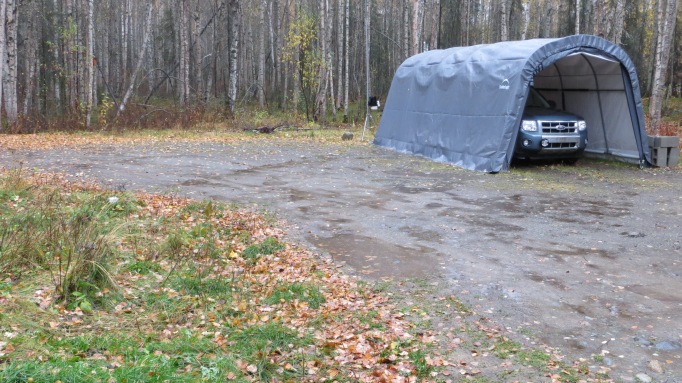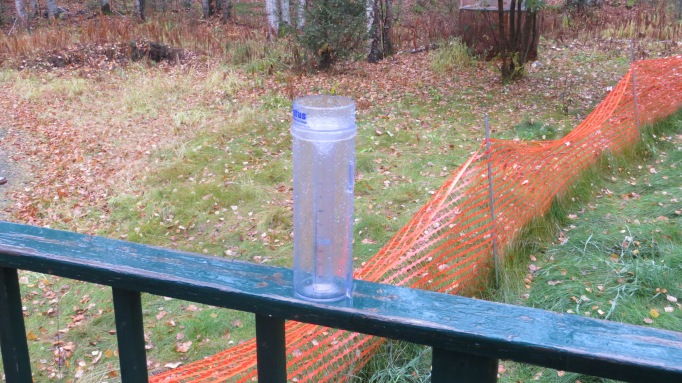Most folks following this blog know of my fascination with meteorology and my expression of said interest by participating in volunteer functions like ‘Skywarn spotting’ and ‘CoCoRaHS’ (Community Collaborative Rain, Hail and Snow network) as well as reporting on the marvelous extremes of weather in The Last Frontier. I’ve always been a sky watcher and had learned to predict short term weather in the lower 48 just by observing the clouds and winds along with the barometric pressure. Since relocating to Alaska I’ve had to re-learn this knowledge as it is quite different this far north but I’m having great fun undertaking this re-education.
August is historically Talkeetna’s rainiest month averaging 4.5″ (11.43 cm) of rain but September is a close second at 4.2″ (10.67 cm) of rain. As you may know from June and July’s wildfires in The Great Land 2015 has been very dry, at least up until this month. During 2015 only July hit its historical rainfall amount although obviously September is going to grossly exceed its ‘typical’ rainfall! As I watch the ongoing moderate rains out my office window I am again reminded that in Alaska the weather rules and we humans are just along for the ride and must learn to be both flexible and patient. Since this latest rain event started last Saturday evening I’ve recorded 2.14″ (5.44 cm) of rain with 1.44″ (3.66 cm) of that amount occurring between 07:00 Sunday morning and 07:00 this (Monday, 09/28) morning. Since sending in that report to CoCoRaHS this morning I’ve accumulated another 0.33″ (0.84 cm) or so as of 10:40 AKDST and the rain continues:
I believe the aforementioned 1.44″ (3.66 cm) of rain across a 24 hour period is the largest amount I’ve recorded during such a time period since relocating to Alaska in September of 2013.
Yet this rain is just the precursor to what could well be significant accumulating snowfall which NWS is currently projecting to begin in roughly 24 hours for this area. Everything depends upon the speed at which the very cold mass of Siberian air moves into the Mat-Su Valley; the faster this happens the more snow we will receive. If it happens sooner than forecast we could see over 6″ (15.24 cm) of snow especially at elevations above 1,000 feet (304.8 m) in the Susitna Valley with larger accumulations further north. If it arrives later then we’ll see more rain and less snow. I sympathize with the forecasting folks at NWS because so much affects the movement of such an air mass like pressure, upper level winds, lower level winds in the mountains and temperature.
I am very concerned about the rain; given we’ve already seen 2.14″ (5.44 cm) since the event began Saturday evening and the rain is forecast to continue as moderate to heavy rain into Tuesday we could see amounts above 3.5″ (8.89 cm) across the period. Because the ground is already beginning to freeze the water cannot soak in as well and hence tends to pool and form torrents which can and do wash out the local road system. I am expecting to pick up a buddy flying from SW Michigan to Anchorage this Wednesday (09/30) evening and the only driving route to Anchorage is the Parks Highway (AK 3) to the Glenn Highway (AK 1). There are numerous areas along the Parks between Talkeetna and the intersection with the Glenn which have washed out in the past and these conditions are as extreme in terms of rain as any I’ve experienced in my 24 months living up here. I have driven the Parks in snow and ice but I’ve never had to negotiate washed out areas; at least that hadn’t been repaired before my arrival.
While I love snow and cold I must admit to hoping that the rains do not continue as they sure appear they will do; I’d rather negotiate a foot (30.48 cm) of snow than try to navigate washed out portions of the Parks! Ironically my buddy is visiting in part to assist me with mounting an electric winch on my Escape; at least I do have a hand powered ‘come along’ capable of moving 4,000 pounds (1,841.4 kg) in the back cargo area along with my standard winter survival kit. I never thought I’d be hoping for little snow and no more rain but this is the case! I will remain glued to the NWS and ADOT websites especially tomorrow morning moving into Wednesday. It appears Alaska is looking to test me once again and I can only rely on my experience and the reports from the aforementioned services to determine if I should attempt the drive Wednesday evening. At least my buddy has the option of getting a rental car and motel room should the worst come to fruition…

I’ve never seen so much ponding water on my driveway! In fact I can never remember seeing any pools of water on the portion in this image!!


